Nina Munteanu's Blog, page 2
March 10, 2024
Nina’s “Favorite 3 Reads Of 2023: Feminist Eco-Fiction
In late 2023, I was invited by Shepherd to post an article of my favourite three reads of 2023. I had earlier that year posted on Shepherd an article describing what I considered to be the best eco-fiction books that make you care and give you hope.
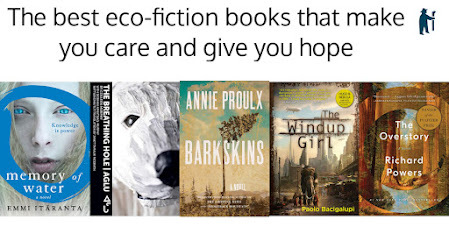
I started out by reviewing what I had read in 2023. It looked like I’d read about thirty odd books, almost half and half non-fiction to fiction. That’s not many, but I’m a slow reader. I pore through each book at a snail’s pace, spending time making notes with some, particularly the non-fiction books, which I use to research my writing. With fiction, I dive in deep and thoroughly savor each word and sentence like a mouthful of an excellent meal made with loving hands. Books varied from non-fiction scholarly works on forest ecosystems (The Treelineby Ben Rawlence) and post-capitalism (Four Futuresby Peter Frase) to literary fiction, political thrillers, speculative fiction, clifi, and eco-fiction.
It was a tough choice, but I came up with three choices and a thematic rationale that resonated with me and made a deep kind of sense for that year: all three books were eco-fiction of sorts and featured hopeful stories of strong women, acting out of compassion and in solidarity with intelligence, kindness and courage. For me, 2023 was a year of strong feminine energy for the planet and my favourite books reflect that. Here they are (read the original article on Shepherd here):
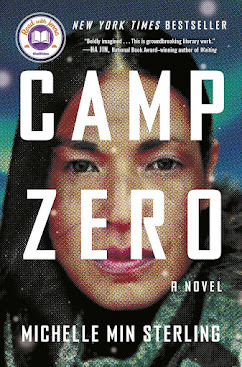
The first of my favourite three books of 2023 is Michelle Min Sterling’s Camp Zero.
Set in the remote Canadian north—a place I love for its harsh beauty—this feminist climate fiction explores a warming climate through the perilous journeys of several female characters, each relating to her environment in different ways. Each woman exerts agency in surprising ways that include love, bravery and shared community. The strength of female power carried me through the pages like a braided river heading to a singular ocean. These very different women journey through the dark ruins of violent capitalism, colonialism and patriarchy—flowing past and through hubristic men pushing north with agendas and jingoistic visions—to triumph in an ocean of solidarity. I empathized with each woman as she found her strength and learned to wield true heroism—one based on collaboration and humble honesty.
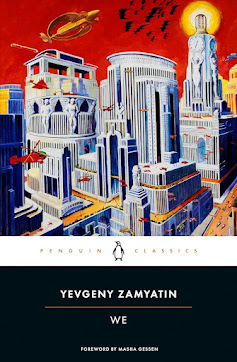
My second favourite book of 2023 is Yevgeni Zamyatin’s We.
I enjoyed this 1920 hopeful dystopia for its courageous and unprecedented feminism.
While the story centres on logical D-503, a man vacuously content as a number in the One State, it is I-330—Zamyatin’s unruly heroine—who stole my attention. Confident, powerful and heroic, the liberated I-330 embraces the Green Wind of change to influence D-503. A force of hope and resilience, she braves torture to successfully orchestrate a revolution that breaches the Green Wall—feats typically relegated to a male protagonist in novels of that era.When pregnant O-90 refuses to surrender her child to the State, I-330 helps her escape to the outside, where the Green Wind of freedom blows.I resonated with Zamyatin’s cautionary tale on the folly of logic without love and Nature.
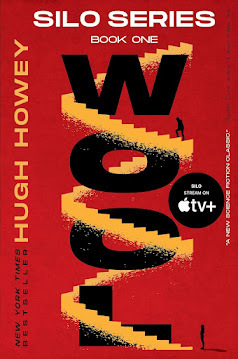
My third favourite book of 2023 is Hugh Howie’s Wool(first of the SILOseries).
Juliette—humble and gutsy, kind and relentlessly motivated in her journey for the truth—kept the pages turning for me. Juliette is a mechanic from the Down-Deep of the underground Silo, humanity’s last refuge to a toxic world. When Juliette inexplicably lands the job of sheriff, she treats her new position as a tool to seek the truth about her lover’s mysterious recent death. At her own peril, she pulls on threads that ultimately reveal a great conspiracy.
Juliette’s literal and metaphoric rise from the Down-Deep to the Up-Top is a feminist’s journey that transcends intersectional barriers as she battles small-minded men of power and maintains her integrity by refusing to abide by the inhumane Up-Top rules of order. By the end, I sensed a victory for humankind through womankind.
Also check out Shepherd’s 100 best books of 2023.
You might be interested in two of my own eco-fiction novels that feature several strong female protagonists:
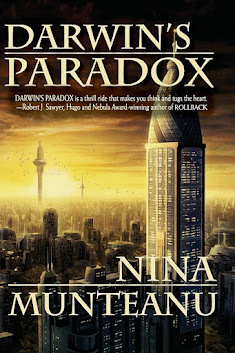
Darwin’s Paradox follows the complex dynamic of a brave mother and her willful teenage daughter, both ‘gifted’ by a virus living inside them. Accused of murder and deliberately spreading the virus that killed many, Julie fled the enclosed city and settled in the climate wastelands with her husband and their child. Years later, when their harsh refuge is threatened by city forces seeking mother and daughter for experimentation, Julie leaves her family and gives herself up to the city, hoping they will abandon pursuing her daughter. Still psychically connected to the city’s AI community (now evolving into an autonomous entity with the intelligent virus), Julieentangles with political intrigue while her daughter, who followed her to the city, stumbles into her mother’s violent past.
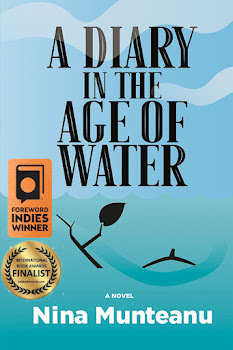
A Diary in the Age of Water follows the climate-induced journey of Earth and humanity through four generations of women, each with a unique relationship to water. Centuries from now, in a dying boreal forest in what used to be northern Canada, Kyo, a young acolyte called to service in the Exodus, yearns for Earth’s past—the Age of Water—before the “Water Twins” destroyed humanity. Looking for answers and plagued by vivid dreams of this holocaust, Kyo discovers the diary of Lynna, a limnologist from that time of severe water scarcity just prior to the destruction. In her work for a global giant that controls Earth’s water, Lynna witnesses and records in her diary the disturbing events that will soon lead to humanity’s demise.
January 16, 2024
Winter Beauty... Photographs by Nina Munteanu
October 25, 2023
Nature’s Elegance: When Dying is Beautiful…
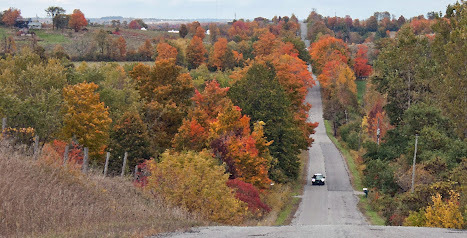
It started with my need for change. My need to discover. To witness beauty. That meant going outside. And I knew exactly where to go.
I made a lunch and took some snacks, saddled myself in Benny (my trusted VW steed) and drove west.
It was late October and the cold winds hadn’t yet cajoled the colourful leaves off the maples, aspens, birches and oaks. I knew I would witness something remarkable. I was in the north temperate zone of Canada, after all, and this was the height of autumn magic…
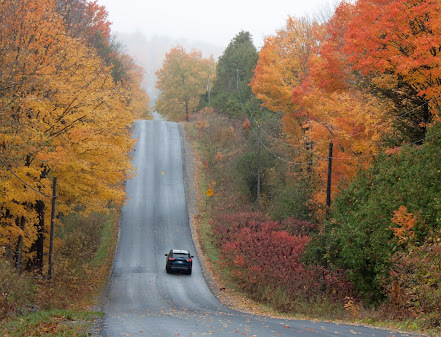
Soon, I was driving along one of my favourite country roads, a gently rolling barely paved road through forest and farmland that rose and fell over drumlins and eskers with views that make you sigh. A vibrant carpet of orange-crimson forest and copper-hued fields covered the undulating hills in a patchwork of colour.
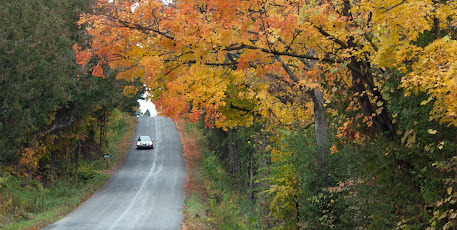
I stopped frequently and stepped out into the light rain to take photographs. The air was fresh and clean against my skin as I breathed in the scent of wet vegetation and loam. A light mist washed the distant hills in muted shades of a watercolour painting. The nearby forests were anything but muted. I drove past flaming thickets of red-purple dogwoods and sumacs. Benny took me beneath neon canopies: the brilliant orange and deep reds of sugar and red maples, the lemon yellows and bronzes of aspens, oaks and beeches.
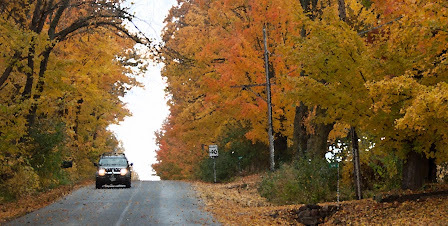
The flaming colours signify approaching death for the leaf. The deeper the colour, the closer to the end.
With less light in fall, the green sugar-making pigment, chlorophyll, starts to break down. Other pigments, previously masked by the chlorophyll are revealed: the red-purples of anthocyaninand the oranges and yellows of carotenoids.As chlorophyll degrades, light striking the leaf may cause injury to its biochemical machinery, particularly the parts that regulate nutrient movement. So, these other pigments help to create a physical light shield and help the leaves efficiently move their nutrients into the twigs for the tree to use later.
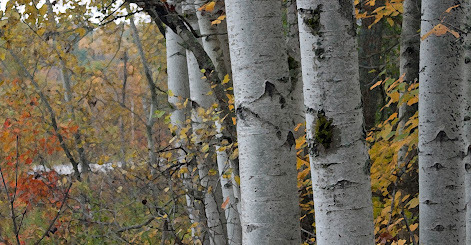
As the temperature plummets, the trees build a protective seal between the leaves and their branches, taking in as many nutrients as possible from the sugar-building leaves. Once the leaves are cut off from the fluid in the branches, they separate and drop to the ground, helped by the winds. Even in death, the leaves continue to contribute. On the ground, the fallen leaves decompose and restock the soil with nutrients; they also contribute to the spongy humus layer of the forest floor that absorbs and holds rainfall. Fallen leaves are also food for soil organisms, whose actions in turn keep the forest functional.
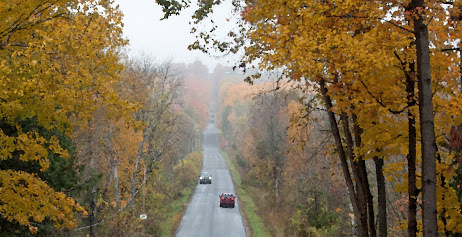
As I wove through the deep colours of autumn, I felt humbled by this naked beauty, so simply shown. So ingenuously revealed. How elegantly yet guileless nature went through its stages of individual dying to ensure renewal and growth for the whole.
I returned home, invigorated and humbled by nature’s transient show.
Within weeks, the bright leaves would fall, leaving the trees bare and gray and the ground a thick slippery carpet of brownish gray-black rot. Beauty enfolded, dissected and integrated. Insects, fungi, and bacteria would deliver what the leaves used to be and create something else, a gift to the living forest.
Is that not what death is? The end of something to ensure the beginning of something else?
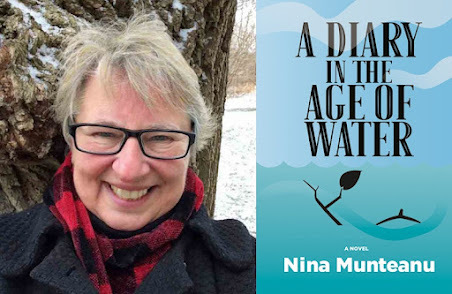
Nina Munteanu is a Canadian ecologist / limnologist and novelist. She is co-editor of Europa SF and currently teaches writing courses at George Brown College and the University of Toronto. Visit www.ninamunteanu.ca for the latest on her books. Nina’s bilingual “La natura dell’acqua / The Way of Water” was published by Mincione Edizioni in Rome. Her non-fiction book “Water Is…” by Pixl Press(Vancouver) was selected by Margaret Atwood in the New York Times ‘Year in Reading’ and was chosen as the 2017 Summer Read by Water Canada. Her novel “A Diary in the Age of Water” was released by Inanna Publications (Toronto) in June 2020.
September 17, 2023
Mistakes Authors Make (When We Don’t Pay Attention to Place and Things)

In “A Dance of Cranes” (Dundurn, 2019) author Steve Burrows erroneously describes the actions and motions associated with canoeing. In the following scene, the protagonist Jejeune is canoeing on a river in the boreal wilderness of northern Canada:
The low sun seemed to light the stand of birches from within, flickering through the trunks like a strobe light as Jejeune rowedpast.
One does not row a canoe; one paddles—with a paddle.
You might think that this is a small error, hardly worth mentioning; however, the friend who pointed out this mistake to me, was thrown out of the novel by it. She is a naturalist and has often gone canoeing in the lakes and rivers of Ontario. This mistake suggested a lack of professional attentiveness from both author and editor of the publication. By compromising the authenticity of the fictional setting the error stopped the reader from participating. We were no longer paddling with Jejeune; we were looking at the book.*
Some of you may rail at me for being overly harsh. You would remind me that this is a work of fiction, after all, not fact. You’d remind me that fiction is a work of the imagination, of characters and journeys; not a dry documentary.
I would agree with you—up to a point. Certainly, in fiction we can and do take liberties with “facts” so long as the narrative keeps the reader moving in the “fictive dream.” Authors have managed to successfully bend reality considerably in the past to great effect because the reader was fully engaged in the narrative and the characters.
But ultimately, beginning-to-end factual accuracy remains important in a made-up story for various reasons. While some “fake facts” or mistakes (such as the example above) may slip by many readers unnoticed, someonewill notice. Guaranteed. And, as with my naturalist friend, it can make the difference between a seamless read and a jarring one. Writer Dorian Boxshares that, “Some readers may even post reviews criticizing your book on that basis.” Dorian adds that when they spot large factual inaccuracies in a novel, “it detracts from the reading experience. I start to question other things. Credibility is damaged.”
All good fiction is anchored by consistent and believable world-building, whether the story is set in contemporary New York City or a made up planet in some made up solar system. The key to this believability is the use of grounding ‘facts’ or world-consistencies that immerse the reader in the story world. The reader relies on the author to realistically represent the world they are reading about. This allows the reader to experience the story as though it was real. Representing the facts accurately enables the writer to take liberties with other aspects of the story. Because the reader is nicely embedded in the world through accurate depiction, they will follow your characters through it eagerly.
The Importance and Ease of Research in Fiction Writing
To prevent what happened in the example I gave above, authors must exercise due diligence in world building, in representation of setting and place, and in other elements of the story. Writers have easy access to so much knowledge about so many topics through local libraries, local experts, the internet, social media, and more. In other words, no excuse.
In the novel I’m currently working on I needed to understand what it felt like to handle, load and shoot a particular make of shotgun. I had handled one in the past but not actually used it. The internet provided exceptional instructional videos and sites that I could use to come close to the actual experience. I paid particular attention to nuances and sensual aspects such as texture, smell, weight, as well as mechanical aspects, like recoil; anything that would more viscerally help me experience it. When I had written the scenes, I showed them to someone who had handled a shotgun for their verdict on accurate depiction.
For more examples and discussion on place and doing research, check out Chapter H and R of my first book in TheAlien Guidebook Series“The Fiction Writer: Get Published, Write Now!”and Part 2 of my third book in the series “The Ecology of Story: World as Character.”
*There is such a thing as a rowing canoe; canoes can be set up for rowing with oarlocks and sockets, oars, rowing seats and even forward rowing contraptions such as foot brace for efficient rowing. However, this was not the case in the book I gave as an example.

Nina Munteanu is a Canadian ecologist / limnologist and novelist. She is co-editor of Europa SF and currently teaches writing courses at George Brown College and the University of Toronto. Visit www.ninamunteanu.ca for the latest on her books. Nina’s bilingual “La natura dell’acqua / The Way of Water” was published by Mincione Edizioni in Rome. Her non-fiction book “Water Is…” by Pixl Press(Vancouver) was selected by Margaret Atwood in the New York Times ‘Year in Reading’ and was chosen as the 2017 Summer Read by Water Canada. Her novel “A Diary in the Age of Water” was released by Inanna Publications (Toronto) in June 2020.
August 2, 2023
The Writer-Editor Relationship, Part 2: Editors Preparing Writers
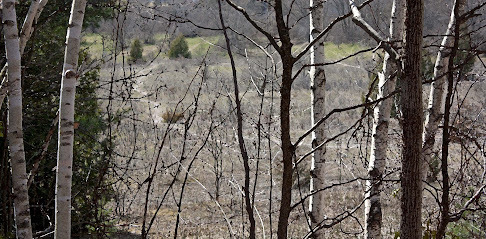
In my previous article, “Five Things Writers Should Look for in an Editor,” I focused on clarifying expectations between editors and writers from the writer’s point of view.
Part 2, this article, focuses on this same relationship from the editor’s point of view. If you are a writer, this article serves as a workable checklist of what you should expect from a good editor.
Realizing Expectations
Indie authors often come to editors with unclear and, at times, unreasonable or unrealistic expectations on services. Many writers know very little about the kind of editing we do and the different levels of effort (time and associated fee) required. They do not understand the difference between “copy-editing” and “structural editing”, particularly as it pertains to their own work. In fact, many indie writers don’t even know what their MS requires. This is because of two things: 1) they can’t objectively assess their own work, particularly in relation to market needs; and 2) many authors have not sufficiently considered their “voice” or brand and matched it to a relevant target market. Both of these will influence how the writer comes into the relationship and the nature of their expectations.
It is best to be “up front” with everything, from understanding a writer’s work and market expectations to establishing your fees, your time, and the nature of your services. This is why a savvy editor will ask for a one to several page example of the author’s writing prior to offering their services and finalizing the nature of a potential relationship. Such an exchange may, in turn, include a sample of the editor’s work for the writer to assess. This exchange helps clarify the process for both parties.
A savvy editor will want to establish with the author the following things prior to taking him/her on as a client and embarking on the actual editing task:
1. The nature of the writer’s work: a writer’s work should harmonize with the editor and achieve a good fit; e.g., I edit fiction and non-fiction; however, I do not edit horror, because I simply can’t relate to it and don’t care for it. More on this below.
2. The author’s expectations and target market: this is key to establishing the kind of editing required for the author’s piece. Is it good enough to just copy-edit or will the piece require substantive edits to succeed in the identified market? This often requires open and frank communication between editor and author.
3. Nature and time of submission: on which the schedule is based.
4. Schedule and deadlines for deliverables: based on the editor’s realistic timing (including other work) and the nature of the editing job (to be established by some reliable means).
5. Nature of communication: form and frequency; partly to ensure that the writer does not abuse the communication stream with a barrage of emails, e-chats, phone calls, etc.)
6. Nature and cost of deliverables: e.g., use of track changes; inclusion of summary letter; follow up meetings, etc.
7. Mutual agreement on fees, fee structure and payment details: what, how and when.
8. Inclusion and nature of contract: this may include an NDS, if desired.
By clarifying these, you and the author create a new set of realistic agreed-upon expectations.
Fitting Writer with Editor
The right fit for editor and writer includes more than harmonizing genre, writing style, and content. The fit includes personality. A professional editor and writing colleague of mine recently shared on our list-serve about his experience as both a freelance and publishing house editor. The editor shared that a majority of writers responded to his edits with comments like, “finally, someone who just comes out and plainly tells me what’s wrong!” However, others complained: “why are you so mean?” The editor admitted to using humor liberally in his assessments and was described by one of his clients as “playfully harsh.” While the work of this editor is no doubt impeccable, the added humor may not be a good fit for some writers, particularly those who are not highly confident in their work.
Knowing your own brand of editing and being up front with it is part of achieving a good fit with a writer and can avoid huge headaches down the line for both of you.
Toward Honesty & Moral Integrity
I and some of my editing colleagues have run across several cases of indie writers who have come to us with “already edited works” that they believed only needed proofing or minor edits, but in fact called for substantive editing and story coaching to fulfill market requirements. The previous editor had either done a poor job of editing or the author had done a poor job of incorporating the edits. Either way, I was now in the position to inform this author, who had already spent several thousand dollars on edits, that his work required more than a “trim job off the top” to meet the standards demanded by the market.
My colleague suggested that it is unethical to copy-edit a manuscript that obviously requires structural editing or has serious “story” problems. I’m inclined to agree. The key lies in the expectations of the author and his/her intended market. This is where the editor’s knowledge of “matching work to market” becomes a critical part of the relationship with the author, whether you take him/her on as a client or not. I talked more about this in an article on Boldface: “The Moving Target of Indie Publishing: What Every Editor (and Writer) Needs to Know.” Honesty is best. Following the path of moral integrity may not put food on the table; but it will maintain your reputation as an editor of quality, which will keep the roof over your head.
Below is a mock email of a general response to a writer’s inquiry for help on their MS:
Dear Alice,
Thank you for your interest in my editing services. I am still taking on clients and would be happy to help you.
In your initial letter, you included a brief description of your story. It sounds intriguing and interesting. Science fiction is my passion (I’ve published nine SF books so far).
Before we proceed, I need a few things from you to ensure we are a good fit and to help me do the best I can for your project. First, can you please send me a short sample of your work (2-3 pages) and a very short summary. From this I’ll be able to confirm the kind of editing that best suits your project. For the kinds of editing/coaching services and associated fees please refer to this page on my website: xxxx.
Can you also answer the following questions?
1. (If they haven’t included the genre or a short premise, I ask them for one).
2. How do you intend to publish this book (traditional, indie, self-publish)?
3. Who would you say is your intended audience and market?
4. Is this book a stand alone or part of a trilogy or series?
5. Is the book complete (first draft or more)? If not, how much is written?
Based on this, I will suggest the kind of editing (and coaching) required to best fit your needs. This may be one or a combination of the following: 1) an evaluation/assessment at $xx/page; 2) copy-editing (with some substantive editing) at $xx/page; or 3) story coaching at $xx/hour. As outlined on my webpage (xxxx), I provide digital commentary (line by line) in your manuscript (in Word through track changes) accompanied by a summary letter with recommendations. You can find examples of what I do on this page of my website: xxxx.
Once I’ve determined what services best suit your work and you are in agreement with the service and fees, I will draw up a contract for you and I to sign. The contract will stipulate a reasonable schedule that you and I can agree on for the process and deliverables.
Once the contract is signed by both of us, I would ask that you send me your material along with Paypal payment for the first half of the agreed total fee by the date marked in the contract.
I look forward to hearing from you.
Best Wishes,
Nina
July 5, 2023
Nina Munteanu Talks About The Author's Writing Process
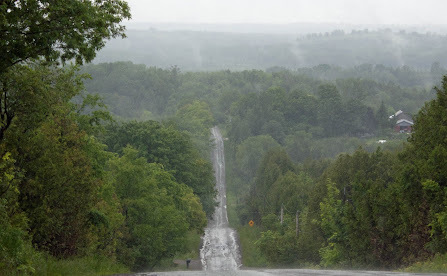
Issue #128 of Apex Magazine featured an interview that Rebecca E. Treasure did with me. We discussed the power of story, the use of dystopian narrative, and the blur between fiction and non-fiction to create meaningful eco-fiction. Below we talk about the writing process I use for my stories these days. For the complete interview go here:
AM: The language in your stories is richly thematic, using strong description to weave the subtext into the piece. For example, “killing two squirrels with one stone.” Is that something that comes about organically as you compose a piece, or a more intentional part of editing?
NM: I use both processes to achieve a final narrative that is multi-layered with metaphor, symbols, and deep meaning. The first process is through intuition derived through intimacy; the second process is more deliberate and generated through objectivity. Insights from intimacy come about organically, during moments of true inspiration, when my muse connects me to the deeper truth of a character’s voice and actions. Given that the inner story runs many layers (some of which I, as writer, may not even be overtly aware) and links in a fractal relationship with the outer story, those moments of inner inspiration happen as if of their own accord. That’s what writers mean when they admit that their characters “talk” to them and instruct them on what to write. When a writer achieves that level of intimacy and understanding, they can let the muse guide them.
Much of the description that is woven into story is generated through the editing process when I read the manuscript as a reader. The process involves letting the story sit for a while so when I return to it, I am reading more objectively. During this process, I apply my knowledge in storytelling craft to showcase combustible moments in plot, and work in foreshadowing, subtext, and compelling metaphor. A writer can’t add metaphor without context related to story theme (otherwise this may result in what the industry calls “purple prose”). Metaphor—given its roots in the deeper psyche of a culture—must arise organically from a deep, sometimes intuitive, understanding—where the personal meets the universal.
For the entire interview, go to Apex Magazine, December 10, 2021.
May 30, 2023
The Writer-Editor Relationship, Part 1: Five Things Writers Should Look for in an Editor

As indie publishing soars into new heights and successes, writers are looking more and more to freelance editors to help them create works of merit that will stand out in the market. Whether this process is seamless and productive or fraught with difficulties relies on the relationship established between editor and writer—at the outset and throughout.
The writer-editor relationship—like any relationship—works best when communication between parties is transparent and clear. What ultimately drives misunderstanding—or its corollary, harmony—is “expectation” and how it is met. Clarifying expectations on both sides is paramount to creating a professional and productive relationship with few hitches.
Clarity of expectation, honesty, and mutual respect are key features in a productive and successful writer-editor relationship. Writers expect editors to inform them if their expectations are out of line, and writers rely on editors’ honesty and transparency to let them know if they are comfortable with the task being asked of them. This, of course, is predicated on the editor’s full understanding of what that task is; again, it is the responsibility of the editor to determine the scope of work from the author—just as a doctor will ask key questions to diagnose a patient. If an editor has reservations, caveats, or limitations with the project, these should be shared upfront. Honesty is always best, and it should start right from the beginning so that mutual respect is cemented.
Below, I list five things that writers should look for and expect from a good editor. Each of these five items can be determined at the outset, when you and your potential editor first meet. Consider that first meeting as an interview for both of you, to determine if you are a good match.
1. The editor will preserve the writer’s voice through open and respectful dialogue: Losing your voiceto the “hackings of an editor” is perhaps a beginner writer’s greatest fear. This makes sense, given that a novice writer’s voice is still in its infancy; it is tentative, evolving, and striving for an identity. While a professional editor is not likely to “hack,” the fear may remain well-founded.
A novice’s voice is often tangled and enmeshed in a chaos of poor narrative style, grammatical errors, and a general misunderstanding of the English language. Editors trying to improve a novice writer’s narrative flow without interfering with voice are faced with a challenge. Teasing out the nuances of creative intent amid the turbulent flow of awkward and obscure expression requires finesse—and consideration. Good editors recognize that every writer has a voice, no matter how weak or ill-formed, and that voice is the culmination of a writer’s culture, beliefs, and experiences. Editing to preserve a writer’s voice—particularly when it is weak and not fully formed—needs a “soft touch” that invites more back-and-forth than usual, uses more coaching-style language, and relies on good feedback.
An editor colleague of mine consistently accompanies her edits with the question, “Does this change preserve your meaning?” This prompt both focuses on “voice” and reminds the writer that the editor is considering it, which fosters a nurturing environment of mutual respect. Editors who are not familiar with working with writers in the early stage of their careers may wish to defer to one who is more experienced. This is something you should ask when you first find an editor.
Editors also need to consider how the author’s narrative voiceharmonizes with the standard in the author’s targeted genre and niche market. Pursuing respectful and open dialogue about how the author’s voice fits or doesn’t fit that standard is another responsibility of a good editor and one an author will come to rely on—particularly early on in their career.
2. The editor understands—and embraces—the market and genre of your writer: Writers are often told to write what they know. This edict applies equally to editors: edit what you “know” and understand. Each form of writing—from literary and genre fiction to journalism, the memoir, and technical writing—encompasses an overall style, culture and vision, associated language, and even “jargon” that is important to understand to succeed with readers. Even writers who subvert the trope need to first understand what they are subverting, and so does the editor.
I write and edit science fiction and fantasy. I do it very well, because I have a passion for the genre and I intimately understand its world and language, including where the boundaries lie and where the risks—and sublime nuances of originality—also lie. I worked as a scientist for over 20 years and have published papers in peer-reviewed journals, so I am comfortable editing technical and scientific papers. I live that world. On the other hand, I do not read, nor do I understand or care for, the horror fiction genre. Not only would I do a lousy job editing a work of horror, but I wouldn’t provide the discerning editorial advice to best place that work in the horror market. It is in the area of market niche that one editor will shine over another based on their familiarity with, and current activity in, that industry sector. This is ultimately what writers are paying for: the multi-layered understanding of the editor that comes with a full embrace of that world.
Your potential editor should ensure a good fit and the best chance for success by not taking on work in a genre with which they are neither familiar nor comfortable. Which leads me to the next point:
3. The editor is honest and practices moral integrity: they don’t take on a writer’s work unless they like and believe in it: When I was starting out as a writer with my first novel, I shopped it around to many agents, hoping for representation. While the book was eventually published with great success, many agents had rejected it. Literary agents take on clients and shop their books to publishing houses. They usually charge a percentage of the take and are not paid (if they are good agents) until the book is sold to a publishing house. Payment, therefore, is predicated on success. In many cases, an agent would respond with good things to say about my first manuscript but would not take it on, citing this common phrase: “It just didn’t excite me enough.” I was initially puzzled by this response. If they liked it, why didn’t they take it on? But “I like” isn’t the same as “I’m excited.” I soon realized the importance that excitement played in the agent’s business. They were my advocate, after all. If they weren’t eager about the book, how could they sell it to someone else? And if they couldn’t sell it to someone else, how could they get paid?
While the editor is usually paid up front and/or upon deliverable, they fulfill a similar role: that of advocate. If an editor takes on a writer’s work without enjoying it or believing in it, they are much less likely to do a good job. And both lose when that happens.
When we just do a job for the money and not for the passion of doing something well, we run the risk of losing on all fronts. We run the risk of being dishonest in our assessments and then doing a shabby job. And then losing our reputation. Editors need to be an advocate and be honest; sometimes, that means saying “no” to a project and explaining why. As a writer, you are entitled to working with an editor who enjoys your work.
4. Editor edits professionally and appropriately to promised deliverable: In my capacity as writing coach, I have met with several writers who have complained that their work had been insufficiently or inappropriately edited. This can occur for several reasons: (a) lack of time; (b) incompetence; or (c) inappropriate match-up.
(a) Lack of time
As a writer, I once experienced an insufficient copy edit by a freelance professional editor. In fact, this particular editor was a good editor and had impeccably edited a previous work of mine. When I submitted my “edited” work to a beta reader, he pointed out many places that my copy editor had missed. A few is OK, but she’d missed many. From subsequent correspondence, I deduced that my editor had been overrun with other projects and had skimmed mine a little too fast. Unfortunately, this was unacceptable, given that I’d agreed to pay her a professional rate for a specific deliverable: a copy-edited, proofed, and publication-ready manuscript.
The ultimate message here for editors is, don’t take on a writer’s work and make promises of delivering until you know what you’re getting into and know that you can do it in the time you suggested. Honesty is best here. If an editor is too busy to meet the specified deadline, they need to say so and refer the writer to another respected editor if they can’t wait. A smart editor knows they aren’t “losing” the client. But that editor I mentioned in the previous paragraph did. It’s best to create a contract with the editor that is mutually beneficial, transparent, and detailed with reasonably scheduled updates, etc.
(b) Incompetence
Unfortunately, most editors who are incompetent are unaware of it. One of my professional writer-editor colleagues at SF Canada invoked the Dunning-Kruger Effect (“at a certain point, people who really don’t know something don’t know that they don’t know it”) to share her story of what passes for editorial input in “an age of homonym errors.” She suggested that some self-appointed editors are convinced they have significant skills but allow a large error rate.
This is where organizations like Editors Canada become invaluable. Editors Canada certifies editors for skills in various editing fields and forms (that is, structural-, stylistic-, and copy editing and proofreading). Professional editors can be variously certified, and should ensure that they make this known to the writer; many writers not only don’t understand the various editing forms (for example, copy editing vs. structural editing), they also don’t necessarily recognize competence until after the job is done—when it’s too late. You, the writer, are entitled to ask your editor for references, testimonials, certifications and other forms of proven experience before signing on with them.
(c) Inappropriate match-up
This is similar to point 2, which talks about matching writer and editor through genre and market. A good fit also includes temperament, schedules, communication style, and other considerations that will affect the editor-writer relationship and the natural progress of the project. As editor, I have encountered a few clients whose communications with me created tension and misunderstanding. We mutually agreed to terminate our arrangement early on, which saved much tension and grief. The transparency of the relationship allowed us to recognize the mismatch early on and attend to it before it became problematic and wasted both our time and efforts. You can prevent this to some degree by researching the editor’s style and experience with other writers. Many editors—like me—put their testimonials, experience, and even editing examples on their website. Another way to achieve match-up success is to get a referral from a trusted writer friend.
5. The editor keeps the relationship—and language—professional and respectful: Without necessarily expressing this, the majority of writers—particularly beginning writers and, by default, indie/self-published writers—seek a professional editor who will treat them with respect. What this translates into is the use of professional language, tone, and behaviour. You aren’t looking for an editor to be your “friend.” You are also not looking for a professional editor to validate your work or you as a person. As a writer, you seek a professional editor to give you honest and helpful advice that will help you create the very best work you can for eventual publication.
Simple. Not so simple.
As an editor who is also a writer (who gets edited a lot), I provide rationale as much as I can for the suggestions I make to writers and I do it through professional language, tone and behaviour. I am friendly but I keep it professional. This helps establish and maintain a respectful and collaborative relationship between author and editor. Think of it as a doctor-patient relationship; I’ve dropped doctors like hot potatoes who are not willing to sit with me as an equal and discuss their prognoses. I want to know why, and ultimately, it’s mydecision. The editor is an expert, but so is the writer.
In the final analysis, the writer-editor relationship is foremost a professional one. As an editor, I feel it is my duty to promote integrity and respect with the writer, and this hopefully within a safe and nurturing environment for the achievement of mutual excellence. As a writer, I expect my editor to be respectful and act as advocate to my work. I offer my respect on their expertise with communication.
I’ve been edited by many editors, including freelance editors with Editors Canada to publishing house editors throughout North America and beyond. A good editor is like gold in your pocket. They can help you improve your work beyond your own imaginings. In the end, every decision remains yours. While I normally take most of my editor’s advice (usually 95% of the time), I often find the odd place where their suggestion does not fit the heart of my writing. Then I simply say “no.”
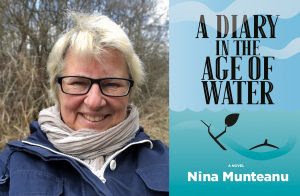
Nina Munteanu is a Canadian ecologist / limnologist and novelist. She is co-editor of Europa SF and currently teaches writing courses at George Brown College and the University of Toronto. Visit www.ninamunteanu.ca for the latest on her books. Nina’s bilingual “La natura dell’acqua / The Way of Water” was published by Mincione Edizioni in Rome. Her non-fiction book “Water Is…” by Pixl Press(Vancouver) was selected by Margaret Atwood in the New York Times ‘Year in Reading’ and was chosen as the 2017 Summer Read by Water Canada. Her novel “A Diary in the Age of Water” was released by Inanna Publications (Toronto) in June 2020.
April 5, 2023
Apex Magazine Interviews Nina Munteanu About Story, Ecology, and the Future
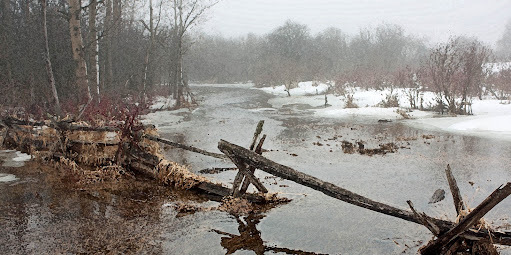
Issue #128 of Apex Magazine featured an interview that Rebecca E. Treasure did with me, posted on December 10, 2021 on their site. We discussed the power of story, the use of dystopian narrative, and the blur between fiction and non-fiction to create meaningful eco-fiction. Here’s part of the interview. For the complete interview go here:
INTERVIEW
Nina Munteanu, author of “Robin’s Last Song,” is a prolific creator with multiple books, podcasts, short stories, and nonfiction essays in publication. Her work spans genre, from eco-fiction to historical fantasy to thrillers, and of course, science fiction. Her work as an ecologist informs all of her writing, which circles around an essential exploration; the relationship between humanity and our environment.
At the top of Nina Munteanu’s website, there is a quote: “I live to write, I write to live.” This sentiment is reflected in her fiction, which is not just about characters in compelling situations solving their problems with compassion, but is about all of us, our planet, our environment, and our future.
Nina Munteanu sat down with Apex for a conversation about story, ecology, and the future.
∞
APEX MAGAZINE: Your novels and short stories examine the role and evolution of humanity in the context of nature and technology. As an ecologist, what do you believe needs to happen—internationally, nationally, locally, and personally—to restore our planet and move forward in a sustainable way?
NINA MUNTEANU: All things animate and inanimate naturally oscillate toward equilibrium or balance in a kind of stable chaos of polarities. Goethe and Hegel told us this long ago. Our actions have exacerbated this oscillation through massive extraction, habitat destruction, and pollution with associated conflicts, take-over and subjugation. Everything is connected and all have contributed to climate change and habitat change. Our mission—given that we’re responsible for much of that imbalance—is to help the planet return itself to balance. That means ensuring that Nature’s natural checks can do their job to ensure functional forests and phytoplankton, a healthy ocean, a resilient biodiversity—all systems that we rely on for our own healthy existence. Restoring our denuded global forests, and the oceans will need the concerted and united efforts of all nations and individuals. We have the knowledge, the science, and technology; all that is needed is the will. And that can only change as our own narrative changes. That’s where storytelling plays a key part. Surveys have proven that fiction can be deeply persuasive through character journey that convinces at a deeper more emotional level (as opposed to a litany of facts that appeals only at an intellectual level).
AM: Do you believe industry and sustainability are compatible? What about colonialism and sustainability? Capitalism? In other words, is sustainability something we can achieve with our current systems, or is global systemic change required?
NM: Some people—mostly economists—would say definitely yes to the first question; we just need to be conservationist in our approach to doing business. But the very basis of capitalism is exploitation, not conservation. The driving force behind capitalism is fear and uncertainty and its main process is exploitation. From an ecologist’s perspective, this makes sense for a community during its early succession and growth stage … when it first colonizes a new area. Ecologists call this approach r-selected (for rate), based on the need to be profligate and fast-growing to successfully establish. But as we reach a climax community and our carrying capacity—where we are now—this r-selected approach no longer works. We need an economic model that better matches this new paradigm. NOT based on continued growth! A climax global economy, one based on cooperation not competition. Elisabet Sahtouris calls this ecological economy “ecosophy.” In his book Designing Regenerative Cultures, Daniel Christian Wahl talks about changing our evolutionary narrative from one based on fear defined by a perception of scarcity, competition, and separation to one based on love defined by a perception of abundance, a sense of belonging, collaboration, and inclusion. He promotes a regenerative economy based on true reciprocation.
And moving forward we can take a lesson from Robin Wall Kimmerer who promotes a gift economy—an economy of abundance—whose basis lies in recognizing the value of kindness, sharing, and gratitude in an impermanent world. This is what she says: “Climate change is a product of [our] extractive economy and is forcing us to confront the inevitable outcome of our consumptive lifestyle, genuine scarcity for which the market has no remedy. Indigenous story traditions are full of these cautionary teachings. When the gift is dishonored, the outcome is always material as well as spiritual. Disrespect the water and the springs dry up. Waste the corn and the garden grows barren. Regenerative economies which cherish and reciprocate the gift are the only path forward. To replenish the possibility of mutual flourishing, for birds and berries and people, we need an economy that shares the gifts of the Earth, following the lead of our oldest teachers, the plants.”
AM: The language in your stories is richly thematic, using strong description to weave the subtext into the piece. For example, “killing two squirrels with one stone.” Is that something that comes about organically as you compose a piece, or a more intentional part of editing?
NM: I use both processes to achieve a final narrative that is multi-layered with metaphor, symbols, and deep meaning. The first process is through intuition derived through intimacy; the second process is more deliberate and generated through objectivity. Insights from intimacy come about organically, during moments of true inspiration, when my muse connects me to the deeper truth of a character’s voice and actions. Given that the inner story runs many layers (some of which I, as writer, may not even be overtly aware) and links in a fractal relationship with the outer story, those moments of inner inspiration happen as if of their own accord. That’s what writers mean when they admit that their characters “talk” to them and instruct them on what to write. When a writer achieves that level of intimacy and understanding, they can let the muse guide them.
Much of the description that is woven into story is generated through the editing process when I read the manuscript as a reader. The process involves letting the story sit for a while so when I return to it, I am reading more objectively. During this process, I apply my knowledge in storytelling craft to showcase combustible moments in plot, and work in foreshadowing, subtext, and compelling metaphor. A writer can’t add metaphor without context related to story theme (otherwise this may result in what the industry calls “purple prose”). Metaphor—given its roots in the deeper psyche of a culture—must arise organically from a deep, sometimes intuitive, understanding—where the personal meets the universal.
AM: Your work takes complex topics that are nonetheless critical to humanity’s future and pulls stories with compelling characters out of them, making the science accessible, the warnings personal to the reader. This has always been one of the callings of science fiction. What is the role of stories in the climate action movement?
NM: Our capacity and need to tell stories is as old as our ancient beginnings. From the Paleolithic cave paintings of Lascaux to our blogs on the internet, humanity has always shared story. Story is powerful in how it helps us define who we are, what’s important to us, and where we are going. Stories compel with intrigue, stir our emotions, connect with our souls through symbols, archetypes and metaphor. Stories inspire action. We live by the stories we tell.
For too long, our stories have promoted a dominant worldview of exploitation and capitalism. We’ve been telling the patriarchal story of “othering” for too long; we need a new voice and a new worldview to replace our old stories of conquering and taming a “savage land” and “savage people.” When Copernicus proclaimed in 1543 that the sun did not revolve around the Earth, it took a long time for the world to accept and let go of its Ptolemaic Earth-centered view. But the world did come around eventually to the point now that this is common knowledge and lies embedded in our daily lives and language.
Storytelling about how the Earth takes care of us and how we can take care of Earth is urgently needed. This means shifting our stories from an exploitive capitalist narrative of separation toward an inclusive partnership narrative. This means embracing a more eco-centric worldview; a worldview in which humanity is not central, but lies embedded within greater planetary forces and phenomena. A worldview that sees humanity only as part of a greater entity, as participant in a greater existential celebration of life and the elements. A humanity that must learn to play along, not bully and take over. A humanity that must embrace compassion, respect and kindness; a humanity directed by humility—not hubris. It is my firm belief that until our worldview embraces humility in partnership with the natural world—until we cast off our self-serving, neo-liberal, capitalist ideologies—we will remain hampered in our journey forward. When we change our stories, we change our lives and we change the world along with it.
This is already happening with the emergence of a strong eco-voice by writers through the feminine voice, the gylanic voice, the voice of the marginalized, of ecology and the environment itself. Authors such as Barbara Kingsolver, Annie Proulx, Margaret Atwood, Richard Powers, Emmi Itäranta Cherie Demaline, Grace Dillon, and Cormac McCarthy give Nature a face and voice to care about. And caring is the first step.
AM: Your stories also bridge fiction with nonfiction, using speculative fiction as a lens to bring your subject into focus for the reader. How does that work? Why do you approach story in this way?
NM: Marcie McCauley with Temz Review observed that, “[Munteanu] does not appear to view fiction and non-fiction as separate territories; or, if she does, then this book [A Diary in the Age of Water] is a bridge between them.” In Herizons, Ursula Pflug called the book “a bit of a hybrid, and Munteanu a risk-taker.” Buried in Print wrote of the same book, “ultimately it exists in an in-between place, some mystical elements of the generational tale possibly alienating the dedicated science-y readers and the instructional elements possibly alienating fiction devotees. And, yet, I read on: strangely compelling.”
I find that I enjoy this in-between place that blurs fiction with nonfiction. It’s more edgy, gripping, and believable, albeit fantastical, even playfully challenging at times. For instance, I may subvert facts, creating semi-facts to tease the discerning reader (e.g. when the diarist in “A Diary in the Age of Water” observed that President Trump had gone blind from staring at the sun during an eclipse; while Trump did stare directly at the sun without eye protection during an eclipse in 2017, he did not go blind—yet). Readers have told me that the story was more impactful; they honestly didn’t know what was taken from fact and what was fictionalized. Such narrative reads like a true story and there is little more tantalizing than eavesdropping on another’s real experience and intrigue. The risk—that the blur will either confuse the reader or invalidate its truths and message—is hopefully addressed through compelling narrative that engages the reader. But this is also why I tend to include an extensive bibliography at the end of a novel or short story.
Readers have told me that my fiction/nonfiction storytelling trope, like “mundane science fiction,” grips my stories with a more keen sense of relevance. Given that I am writing mostly climate fiction and eco-fiction these days, that sense of relevance is exactly what I wish to achieve.
AM: A last question. Both “The Way of Water” and “Robin’s Last Song” showcase the relationships women have with each other, the importance of human connection, the damage that disconnecting from each other can do and, inversely, the power of connection. In your view, what is the role of individuals and local communities in the climate crisis?
NM: There are many things we can do as individuals and as part of a community. I was recently asked this question by the Toronto Star and I responded with three things:
● First, plant a tree; make an actual difference through action. By doing that, we get out from hiding under the bed and face the monster of climate change and show that we care and that we are not alone.
● Second, vote for green politicians. Politicians need to hear directly from their communities. They need you to push them to act on climate change.
● Third, find your tribe and create a movement. Everyone says that people have the power, but that power comes best through numbers and solidarity. Find your tribe and you’ll find yourself more motivated. So, start with you and your home: plant trees; put in a rain garden; put in permeable driveways and solar panels; lower meat intake, especially beef; don’t buy bottled water. Then connect with your physical community and social media community. Let them know what you’re doing and why. Work with your community. All members of a community can help change how your street looks and behaves by communicating with your local government, attending meetings, and having a voice. Initiate a tree-planting program in your parks and street greens. Do stream or lake cleanups. Let the leaders of your community know you care and are willing to do something about it. The wave of change starts local and ripples out into a global phenomenon. Change comes from the heart and heart is where the home is.
∞
For the entire interview, go to Apex Magazine, December 10, 2021.
 Road along Otonabee River on a foggy winter morning, ON (photo and rendition by Nina Munteanu)
Road along Otonabee River on a foggy winter morning, ON (photo and rendition by Nina Munteanu)Rebecca E. Treasure grew up reading science fiction and fantasy in the foothills of the Rocky Mountains. After grad school, she began writing fiction. Rebecca has lived many places, including the Gulf Coast of Mississippi and Tokyo, Japan. She currently resides in Texas Hill Country with her husband, where she juggles two children, two corgis, a violin studio, and writing. She only drops the children occasionally. To read more visit www.rebeccaetreasure.com.
February 9, 2023
Eco Fiction that Makes you Care and Gives you Hope
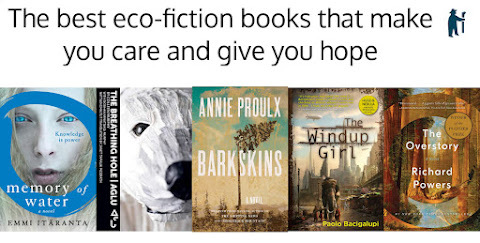
The environment and how we treat it has always been important to me since I was a child. My passion for storytelling morphed into writing, but the underlying park came through environmental activism. I got a university degree in aquatic ecology, published numerous papers, and now write eco-fiction that is grounded in accurate science with a focus on human ingenuity and compassion. The most meaningful and satisfying eco-fiction is ultimately optimistic literature that explores serious issues with heroic triumph. Each of these favourites intimately connects human to environment. Each moved me to cry, think, and deeply care.
Check out what I say about each choice here: https://shepherd.com/best-books/eco-f...
Nina Munteanu is a Canadian ecologist / limnologist and novelist. She is co-editor of Europa SF and currently teaches writing courses at George Brown College and the University of Toronto. Visit www.ninamunteanu.ca for the latest on her books. Nina’s bilingual “La natura dell’acqua / The Way of Water” was published by Mincione Edizioni in Rome. Her non-fiction book “Water Is…” by Pixl Press(Vancouver) was selected by Margaret Atwood in the New York Times ‘Year in Reading’ and was chosen as the 2017 Summer Read by Water Canada. Her novel “A Diary in the Age of Water” was released by Inanna Publications (Toronto) in June 2020.
November 21, 2022
Nine Eco Fiction Novels Worth Reading and Discussing
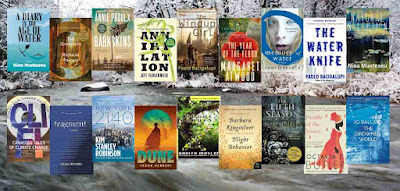
In most fiction, environment plays a passive role that lies embedded in stability and an unchanging status quo. From Adam Smith’s 18thCentury economic vision to the conceit of bankers who drove the 2008 American housing bubble, humanity has consistently espoused the myth of a constant natural world capable of absorbing infinite abuse without oscillation. This thinking is the ideological manifestation of Holocene stability, remnants from 11,000 years of small variability in temperature and carbon dioxide levels. This stability easily gives rise to deep-seated habits and ideas about the resilience of the natural world.
But this is changing.
Our world is changing. We currently live in a world in which climate change poses a very real existential threat to most life currently on the planet. The new normal is change. And it is within this changing climate that eco-fiction is realizing itself as a literary pursuit worth engaging in.
Eco-Fiction (short for ecological fiction) is a kind of fiction in which the environment—or one aspect of the environment—plays a major role, either as premise or as character. Our part in environmental destruction is often embedded in eco-fiction themes, particularly if they are dystopian or cautionary (which they often are). At the heart of eco-fiction are strong relationships forged between a major character and an aspect of their environment. The environmental aspect may serve as a symbolic connection to theme and can illuminate through the sub-text of metaphor a core aspect of the main character and their journey: the grounding natureof the land of Tara for Scarlet O’Hara in Margaret Mitchell’s Gone With the Wind; the over-exploited sacred white pine forests for the lost Mi’kmaq in Annie Proulx’s Barkskins; the mystical life-giving sandworms for the beleaguered Fremen of Arrakis in Frank Herbert’s Dune.
Many readers are seeking fiction that addresses environmental issues but explores a successful paradigm shift: fiction that accurately addresses our current issues with intelligence and hope. The power of envisioning a certain future is that the vision enables one to see it as possible.
“the best part about writing science fiction,” writes Ottawa SF author Marie Bilodeau, “is showing different ways of being without having your characters struggle to gain rights. Invented worlds can host a social landscape where debated rights in this world – such as gay marriage, abortion and euthanasia – are just a fact of life." The emerging sub-genre of ‘mundane science fiction’ addresses Bilodeau’s argument by featuring worlds and people within a new paradigm of ‘ordinary’. Eco-fiction examples of ‘mundane’ include Paolo Bacigalupi’s The Windup Girland Kim Stanley Robinson’s post-climate-change drowned New York 2140.
In fact, eco-fiction has been with us for decades—it just hasn’t been overtly recognized as a literary phenomenon until recently and particularly in light of mainstream concern with climate change (hence the recently adopted terms ‘climate fiction’, ‘cli-fi’, and ‘eco-punk’, all of which are eco-fiction). Strong environmental themes and/or eco-fiction characters populate all genres of fiction from the literary fiction of Richard Powers to the speculative fiction of Margaret Atwood and the science fiction of Frank Herbert. This establishes eco-fiction as a cross-genre phenomenon of literature better described as a focus or treatment than a sub-genre or brand, per se. My thought on the emergence of the term eco-fiction to describe works is that we are all awakening—novelists and readers of novels—to our changing environment. We are finally ready to see and portray environment as an interesting character with agency.
The ten examples I list below of impactful, highly enjoyable works of eco-fiction represent a range of genre, writing style, topic and treatment. Some are optimistic; others are not or have ambiguous endings that require interpretation. The relationship of humanity to environment also differs greatly among these examples as does the role of science. What they all have in common is that they are worth reading and discussing.
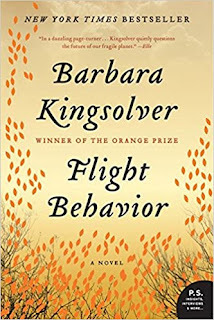
Flight Behavior by Barbara Kingsolver (HarperCollins, 2012) is a literary fiction, whosepremise of climate change and its effect on the monarch butterfly migration is told through the eyes of Dellarobia Turnbow, a rural housewife, who yearns for meaning in her life. It starts with her scrambling up the forested mountain—slated to be clear cut—behind her eastern Tennessee farmhouse; she is desperate to take flight from her dull and pointless marriage of myopic routine. The first line of Kingsolver’s book reads: “A certain feeling comes from throwing your good life away, and it is one part rapture.” Dellarobia thinks she’s about to throw away her ordinary life by running away with the telephone man. But the rapture she’s about to experience is not from the thrill of truancy; it will come from the intervention of Nature when she witnesses the hill newly aflame with monarch butterflies who have changed their migration behavior.
Flight Behavior is a multi-layered metaphoric study of “flight” in all its iterations: as movement, flow, change, transition, beauty and transcendence.Flight Behavior isn’t so much about climate change and its effects and its continued denial as it is about our perceptions and the actions that rise from them: the motives that drive denial and belief. When Dellarobia questions Cub, her farmer husband, “Why would we believe Johnny Midgeon about something scientific, and not the scientists?” he responds, “Johnny Midgeon gives the weather report.” Kingsolver writes: “and Dellarobia saw her life pass before her eyes, contained in the small enclosure of this logic.”
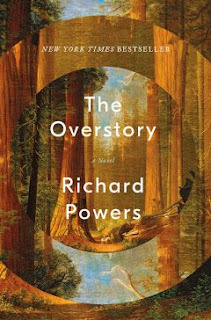
The Overstory by Richard Powers (W.W. Norton, 2018) is a pulitzer prize winning work of literary fiction that follows the life-stories of nine characters and their journey with trees--and ultimately their shared conflict with corporate capitalist America.
Each character draws the archetype of a particular tree: there is Nicholas Hoel's blighted chestnut that struggles to outlive its destiny; Mimi Ma's bent mulberry harbinger of things to come; Patricia Westerfors's marked up marcescent beech trees that sings a unique song; and Olivia Vandergriff's immortal ginkgo tree that cheats death--to name a few. Like all functional ecosystems, these disparate characters--and their trees--weave into each other's journey toward a terrible irony. Each in his or her way battles humanity's canon of self-serving utility--from shape-shifting Acer saccharin to selfless sacrificing Tachigali versicoloured--toward a kind of creative destruction.
At the heart of The Overstory is the pivotal life of botanist Patricia Westeerford, who will inspire a movement. Westerford is a shy introvert who discovers that trees communicate, learn, trade goods and services--and have intelligence. When she shares her discovery, she is ridiculed by her peers and loses her position at the university. What follows is a fractal story of trees with spirit, soul, and timeless societies--and their human avatars.
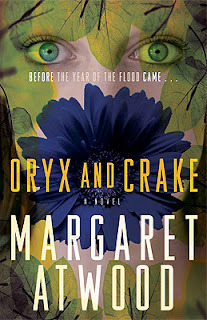
Maddaddam Trilogy by Margaret Atwood (McClelland & Stewart, 2013) is a work of speculative dystopian fiction that exploresthe premise of genetic experimentation and pharmaceutical engineering gone awry. On a larger scale the cautionary trilogy examines where the addiction to vanity, greed, and power may lead. Often sordid and disturbing, the trilogy explores a world where everything from sex to learning translates to power and ownership. Atwood begins the trilogywithOryx and Crake in which Jimmy, aka Snowman (as in Abominable) lives a somnolent, disconsolate life in a post-apocalyptic world created by a viral pandemic that destroys human civilization. The two remaining books continue the saga with other survivors such as the religious sect God’s Gardeners in The Year of the Floodand the Crakers of Maddaddam.
The entire trilogy is a sharp-edged, dark contemplative essay that plays out like a warped tragedy written by a toked-up Shakespeare. Often sordid and disturbing, the trilogy follows the slow pace of introspection. The dark poetry of Atwood’s smart and edgy slice-of-life commentary is a poignant treatise on our dysfunctional society. Atwood accurately captures a growing zeitgeist that has lost the need for words like honor, integrity, compassion, humility, forgiveness, respect, and love in its vocabulary. And she has projected this trend into an alarmingly probable future. This is subversive eco-fiction at its best.
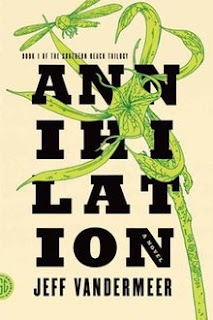
Annihilation by Jeff VanderMeer (HarperCollins, 2014) is a science fiction eco-thriller that explores humanity’s impulse to self-destruct within a natural world of living ‘alien’ profusion.
The first of the Southern Reach Trilogy, Annihilationfollows four women scientists who journey across a strange barrier into Area X—a region that mysteriously appeared on a marshy coastline and associated with inexplicable anomalies and disappearances. The area was closed to the public for decades by a shadowy government that is studying it. Previous expeditions resulted in traumas, suicides or aggressive cancers of those who managed to return.
What follows is a bizarre exploration of how our own mutating mental states and self-destructive tendencies reflect a larger paradigm of creative-destruction—a hallmark of ecological succession, change, and overall resilience. VanderMeer masters the technique of weaving the bizarre intricacies of ecological relationship, into a meaningful tapestry of powerful interconnection. Bizarre but real biological mechanisms such as epigenetically-fluid DNA drive aspects of the story’s transcendent qualities of destruction and reconstruction.
The book reads like a psychological thriller. The main protagonist desperately seeks answers. When faced with a greater force or intent, she struggles against self-destruction to join and become something more. On one level Annihilationacts as parable to humanity’s cancerous destruction of what is ‘normal’ (through climate change and habitat destruction); on another, it explores how destruction and creation are two sides of a coin.
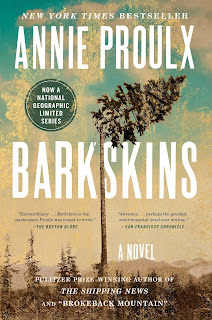
Barkskins by Annie Proulx (Charles Scribner’s Sons, 2016) is a work of literary fiction that chronicles two wood cutters who arrive from the slums of Paris to Canada in 1693 and their descendants over 300 years of deforestation in North America.
The foreshadowing of doom for the magnificent forests is cast by the shadow of how settlers treat the Mi'kmaq people. The fate of the forests and the Mi'kmaq are inextricably linked through settler disrespect for anything indigenous and a fierce hunger for more of the forests and lands. Ensnared by settler greed, the Mi'kmaq lose their own culture and their links to the natural world erode with grave consequence.
Ploulx weaves generational stories of two settler families into a crucible of terrible greed and tragic irony. The bleak impressions by immigrants of a harsh environment crawling with pests underlies the combative mindset of the settlers who wish only to conquer and seize what they can of a presumed infinite resource. From the arrival of the Europeans in pristine forest to their destruction under the veil of global warming, Proulx lays out a saga of human-environmental interaction and consequence that lingers with the aftertaste of a bitter wine.
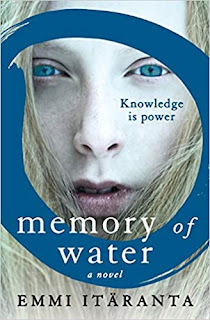
Memory of Water by Emmi Itäranta (Harper Collins, 2014) is a work of speculative fiction about a post-climate change world of sea level rise. In this envisioned world, China rules Europe, which includes the Scandinavian Union, occupied by the power state of New Qian. Water is a powerful archetype, whose secret tea masters guard with their lives. One of them is 17-year old Noria Kaitio who is learning to become a tea master from her father. Tea masters alone know the location of hidden water sources, coveted by the new government.
Faced with moral choices that draw their conflict from the tension between love and self-preservation, young Noria must do or do not before the soldiers scrutinizing her make their move. The story unfolds incrementally through place. As with every stroke of an emerging watercolour painting, Itäranta layers in tension with each story-defining description. We sense the tension and unease viscerally, as we immerse ourselves in a dark place of oppression and intrigue. Itäranta’s lyrical narrative follows a deceptively quiet yet tense pace that builds like a slow tide into compelling crisis. Told in the literary fiction style of emotional nuances, Itäranta’s Memory of Waterflows with mystery and suspense toward a poignant end.
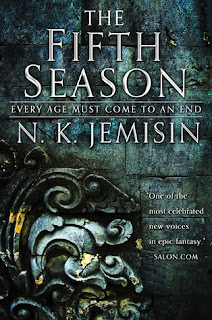
The Broken Earth Trilogy by N.K. Jemison (Orbit, 2018) is a fantasy trilogy set in a far-future Earth devastated by periodic cataclysmic storms known as ‘seasons.’ These apocalyptic events last over generations, remaking the world and its inhabitants each time. Giant floating crystals called Obelisks suggest an advanced prior civilization.
InThe Fifth Season, the first book of the trilogy, we are introduced to Essun, an Orogene—a person gifted with the ability to draw magical power from the Earth such as quelling earthquakes. Jemison used the term orogene from the geological term orogeny, which describes the process of mountain-building. Essun was taken from her home as a child and trained brutally at the facility called the Fulcrum. Jemison uses perspective and POV shifts to interweave Essun’s story with that of Damaya, just sent to the Fulcrum, and Syenite, who is about to leave on her first mission.
The second and third books, The Obelisk Gate and The Stone Sky, carry through Jemison’s treatment of the dangers of marginalization, oppression, and misuse of power. Jemison’s cautionary dystopia explores the consequence of the inhumane profiteering of those who are marginalized and commodified.
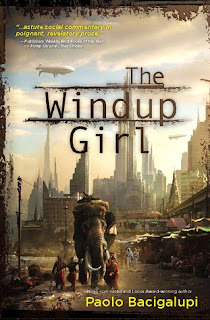
The Windup Girl by Paolo Bacigalupi (Nightshade Books, 2009) is a work of mundane science fiction thatoccurs in 23rd century post-food crash Thailand after global warming has raised sea levels and carbon fuel sources are depleted.Thailand struggles under the tyrannical boot of predatory ag-biotech multinational giants that have fomented corruption and political strife through their plague-inducing genetic manipulations.
The book opens in Bangkok as ag-biotech farangs(foreigners) seek to exploit the secret Thai seedbank with its wealth of genetic material. Emiko is an illegal Japanese “windup” (genetically modified human), owned by a Thai sex club owner, and treated as a sub-human slave. Emiko embarks on a quest to escape her bonds and find her own people in the north. But like Bangkok—protected and trapped by the wall against a sea poised to claim it—Emiko cannot escape who and what she is: a gifted modified human, vilified and feared for the future she brings.
The rivalry between Thailand's Minister of Trade and Minister of the Environment represents the central conflict of the novel, reflecting the current conflict of neoliberal promotion of globalization and unaccountable exploitation with the forces of sustainability and environmental protection. Given the setting, both are extreme and there appears no middle ground for a balanced existence using responsible and sustainable means. Emiko, who represents the future, is precariously poised.
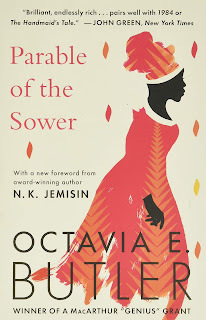
Parable of the Sower by Octavia Butler (Four Walls Eight Windows, 1993) is a science fiction dystopian novel set in 21stcentury America where civilization has collapsed due to climate change, wealth inequality and greed. Parable of the Soweris both a coming-of-age story and cautionary allegorical tale of race, gender and power. Told through journal entries, the novel follows the life of young Lauren Oya Olamina—cursed with hyperempathy—and her perilous journey to find and create a new home.
When her old home outside L.A. is destroyed and her family murdered, she joins an endless stream of refuges through the chaos of resource and water scarcity. Her survival skills are tested as she navigates a highly politicized battleground between various extremist groups and religious fanatics through a harsh environment of walled enclaves, pyro-addicts, thieves and murderers. What starts as a fight to survive inspires in Lauren a new vision of the world and gives birth to a new faith based on science: Earthseed. Written in 1993, this prescient novel and its sequel Parable of the Talent speak too clearly about the consequences of “making America Great Again.”
An earlier version of this article was first published on Tor.com in November, 2020, and again in April 22, 2021 as "Ten Eco-Fiction Novels Worth Celebrating" on Tor.com
More Eco-Fiction Worth Reading:
The following is an updated list of eco-fiction books in addition to those featured above that I have since enjoyed. The list is by no means an exhaustive one, but certainly includes my favourites, those that have impacted me and incited me to think and feel and act:

















